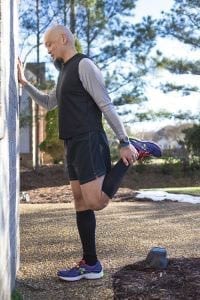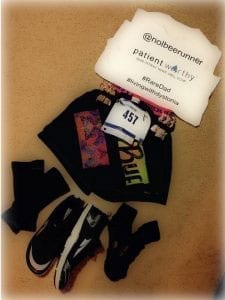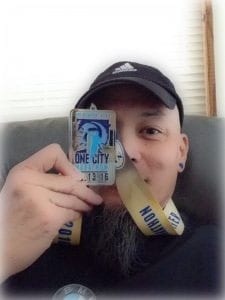Nolan is a rare dad not only living with, but running with dystonia. Patient Worthy has had the privilege of meeting him, working with him in a recent photo shoot, and forming a friendship. Last weekend he completed his first marathon. I sent him a congratulatory text when he crossed the finish line and he sent me this touching letter a few days later, shared here with his permission. Photo above by Sandro Georgi Photography.
Dear Becka,
Now that I’ve had a few days to physically and mentally recover from the One City Marathon, I’d like to share with you what I went through as well as what I have learned.

When I started running consistently a couple years ago after my diagnosis, I never intended to run a marathon. It’s was just a means to mentally deal with the stress of being diagnosed with Generalized Dystonia. Running soon became a passion. Which resulted in a decision to run a marathon. 26.2 miles.
Race day fell on daylight savings time. So at the beginning of the last week, I set my clocks ahead to start acclimating my own internal clock. I had put in the miles. I had put in the core work and the proprioception exercises. I even gave up coffee and beer. The year leading to the race, the time and training that I put in did not prepare me for what was going to happen.

On race day, I set my alarm for 3 am. I wanted to give myself time to wake up and have some breakfast. I had laid out my race gear the night before, so getting dressed at 3 am would be as uncomplicated as possible. I drove for about 40 minutes, north of home. In my anxiousness, I was one of the first people to arrive. Needless to say, I was just a little excited.
In the darkness, I watched other runners file off the shuttles and walk like zombies to the gathering area near the starting line. As they all made their way to the port-o-potties, the music was blasting from a local radio station in an attempt to get the racers amped up for the start of the race. I watched many people find their friends. I watched many people make new friends. At one point, standing amongst all those runners, I felt very alone. Eventually, we all heard the announcement for the racers to report to the starting line.
The horns blew at 7 am, and we were off.
For the first 10 miles I ran among many other runners. All the while, trying to run within myself and sticking to my race plan. And it was at mile 10, that my plan started to come apart. I had noticed that I lost feeling in my left foot. It didn’t bother me. I’ve done training runs with a senseless left foot many times before.
At mile 12, I ran into an aid station, and reached for a cup of water from a volunteer. I dropped it. I reached for another and noticed I couldn’t feel the cup. I had lost sensation in both hands. It was at this point while running, I started performing small neurological tests in my hands to see if my brain and hands were communicating. It was sketchy.
At 13.1 miles, I was running the pace I was hoping to run. And I was still running within myself and not running with everyone else. With every stride, it was getting more difficult to run how I wanted to run. The lack of sensation started to take its toll on my left leg. I could not feel the road. I didn’t know when left my foot was striking the ground, or worse yet, how hard it was striking the ground.
By the aid station at mile 14, my right arm was flexed against my body, making me look like a partial Tyrannosaurus Rex . I had to start reaching for water across my body with my left hand. I dropped a few more cups and decided to start taking my time and walking through the aid stations.
The muscles in my left thigh started to ache. I attributed this to the lack of sensation in my foot. The muscles had to compensate for this neurological communicative malfunction. By mile 16, I adopted a run/walk race plan. However, when I walked, the tone and posturing that I normally experience with my dystonic episodes, well, she reared her untimely head.
My right leg, which I could still feel, would internally rotate as I walked; Pigeon toed. I had to mentally, correct my gait as I moved closer with every step. At the same time, I’d have to use my left hand to straighten my right arm to give it a small break from its contractive state. Oddly enough, if I began running, the internal rotation would disappear. So back and forth it went. Walk with a dystonic right leg or run and risk injury. It was like a chess game. When one means of forward motion became too much to handle, I switched it up. This game went on for miles.
Before I began my taper, my coach had warned me about the last 8 miles. She had said “When you hit mile 18, it will be the most challenging 8 miles of your life.” I found that mile 18 wasn’t that bad, probably because I walked most of it. But on mile 19, when I started running again, that which she described…came to be. I started getting emotional.
All the while, my body was hurting like it never has before. And my mind was saying “Stop! Why are you doing this to yourself?” But my heart and soul were telling me “You can stop when you are done.” So I pressed on, playing the chess game of Dystonia vs. Marathon fatigue.
I was approached by a couple of medics at two separate aid stations as I stopped for water. They both asked if I needed assistance because of how I was stumbling and displaying balance issues. My replies became moments of education and awareness. I said “Thank you, but unless you have a cure for Dystonia, cheering me on is about all you can do.” Not surprisingly, no one knew what Dystonia was… So I made them “aware”!
I pushed on.
When I finally saw the 26 mile marker, I went into a mental overdrive and ran that last two tenths of a mile. If I crashed and burned, so be it. I was going to finish. But before I turned the last corner, I heard someone call my name. I looked over and saw my brother and his wife. Seeing them was a boost and made me feel that everything was ok. With every step, my calves cramped. But I didn’t feel the pain. Finally, I turned the corner and saw the finish line.
I didn’t run across the finish line with my arms raised to the sky. It wasn’t at all glamorous. I stopped running several feet from the line and walked over the finish.
It was truly an emotional and physical roller coaster. Definitely the most difficult thing I have ever done. And I can’t wait to do it again.
Now that it has been a few days since the race it has really sunk in as to what I have accomplished. Not just for myself but for everyone else out there that has dystonia.
A friend of mine sent me this text after I crossed the finish line. That single text helped me put things into perspective.
“You crossed the finish line!!!! Congrats!!!! This is an incredible accomplishment without dystonia, you’ve done something amazing today!”
Initially after the race, I was disappointed. I thought I would be able run the entire marathon, and not have to stop, walk and deal with all that I did. Don’t get me wrong, it was definitely an accomplishment. I executed half of my race plan and modified it as I needed. I stayed within myself. It’s just that my self, I mean my Dystonia self, didn’t agree with me. And that’s OK.

I am pretty proud of myself for setting this goal and following through. And that is what’s important. I hope that my girls look back at this and it becomes a good lesson for them. I explained to them how I was feeling throughout the race. And even though my body and mind told me not to continue, I knew I had to finish because this is part of my path.
Because of this, I have decided I would run more marathons in the future. At least I know what to expect in future races.
I want to do it for myself. I want to become a better runner. If I can do that, and somehow inspire others with Dystonia to press forward and achieve whatever it is they have their sights on…Why wouldn’t I run?
So next time, whenever that may be, I need to go in with zero expectations. I need to run to inspire others, because I love to run. I am a marathoner now and that is what I do.
Many thanks to you and Jenna for helping me become more that just a guy on Instagram and Twitter. The two of you are an inspiration! I’m proud to call you my friends.
Sincerely,
@nolbeerunner
aka. Nolan


